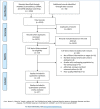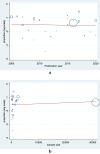Global prevalence of metabolic syndrome among patients with type I diabetes mellitus: a systematic review and meta-analysis
- PMID: 33653388
- PMCID: PMC7923483
- DOI: 10.1186/s13098-021-00641-8
Global prevalence of metabolic syndrome among patients with type I diabetes mellitus: a systematic review and meta-analysis
Abstract
Background: The presence of metabolic syndrome among diabetes patients is frequent and is associated with an increased incidence of chronic complications and mortality. Despite several studies have been conducted, there is no overall estimation on the prevalence of metabolic syndrome among type 1 diabetic patients. Therefore, this study aimed to estimate the pooled prevalence of metabolic syndrome among patients with type 1 diabetes mellitus.
Methods: Medline via PubMed, CINAHL, ScienceDirect, Ovid, Google Scholar, ResearchGate and African Journals Online were searched by limiting publication period from January 2005 to October 2020. Data were extracted with a standardized format prepared in Microsoft Excel and exported to Stata 16.0 for analyses. The I2 statistic was used to check heterogeneity across the included studies. DerSimonian and Laird random-effects model was applied to estimate pooled prevalence and 95% confidence interval across studies. Funnel plot symmetry, Begg's test and Egger's regression test were used to determine the presence of publication bias. Subgroup and sensitivity analysis as well as meta-regression were conducted to explore the potential sources of heterogeneity. The study protocol is registered on PROSPERO with reference number: CRD42020213435.
Results: In this meta-analysis, a total of 27 studies with 45,811 study participants were included. The pooled prevalence of metabolic syndrome was 23.7% with substantial heterogeneity (I2 = 98.2%; P < 0.001). Geographical-based subgroup analysis revealed that the highest prevalence was observed in Australia (27.3%). As per meta-analysis of 17 studies, the pooled prevalence of metabolic syndrome in female type 1 diabetes patients (25.9%) was slightly higher than male T1DM patients (22.5%).
Conclusion: Nearly a quarter of the type 1 diabetes mellitus patients were affected by metabolic syndrome. Therefore, more attention should be paid to the prevention and control of the epidemic and for the reduction of the morbidity and mortality associated with metabolic syndrome among type 1 diabetes mellitus patients.
Keywords: Meta-analysis; Metabolic syndrome; Prevalence; Systematic review; Type 1 diabetes mellitus.
Conflict of interest statement
The authors declare that they have no competing interests.
Figures







References
Publication types
LinkOut - more resources
Full Text Sources
Other Literature Sources
Research Materials

